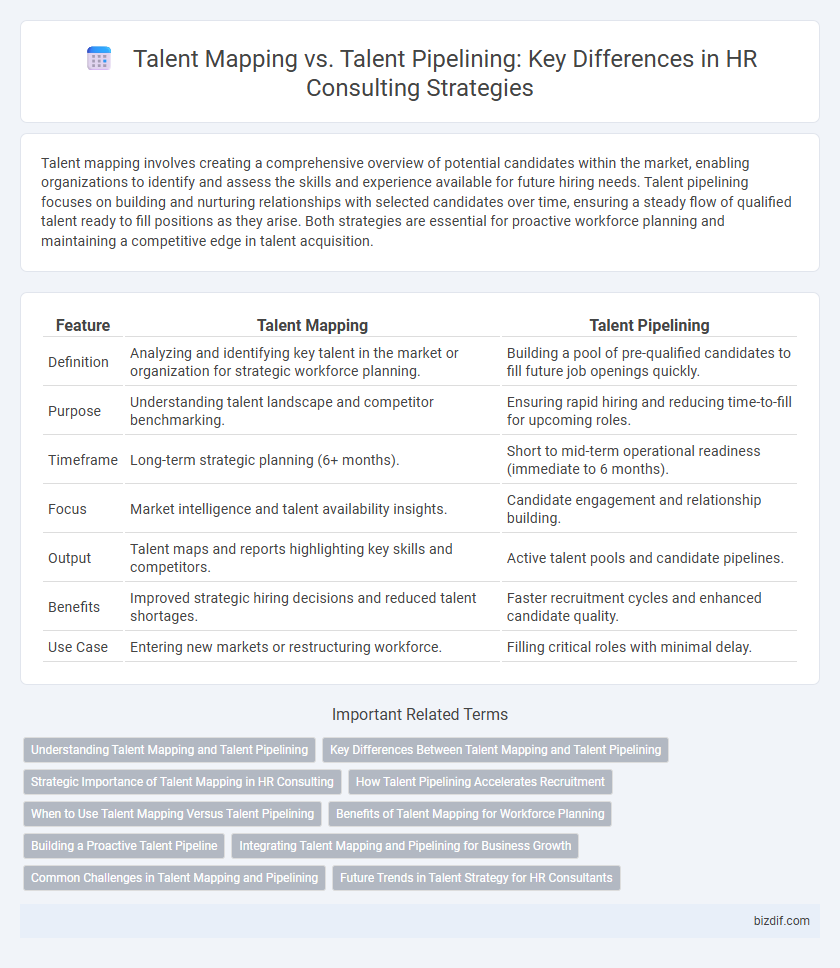Talent mapping involves creating a comprehensive overview of potential candidates within the market, enabling organizations to identify and assess the skills and experience available for future hiring needs. Talent pipelining focuses on building and nurturing relationships with selected candidates over time, ensuring a steady flow of qualified talent ready to fill positions as they arise. Both strategies are essential for proactive workforce planning and maintaining a competitive edge in talent acquisition.
Table of Comparison
| Feature | Talent Mapping | Talent Pipelining |
|---|---|---|
| Definition | Analyzing and identifying key talent in the market or organization for strategic workforce planning. | Building a pool of pre-qualified candidates to fill future job openings quickly. |
| Purpose | Understanding talent landscape and competitor benchmarking. | Ensuring rapid hiring and reducing time-to-fill for upcoming roles. |
| Timeframe | Long-term strategic planning (6+ months). | Short to mid-term operational readiness (immediate to 6 months). |
| Focus | Market intelligence and talent availability insights. | Candidate engagement and relationship building. |
| Output | Talent maps and reports highlighting key skills and competitors. | Active talent pools and candidate pipelines. |
| Benefits | Improved strategic hiring decisions and reduced talent shortages. | Faster recruitment cycles and enhanced candidate quality. |
| Use Case | Entering new markets or restructuring workforce. | Filling critical roles with minimal delay. |
Understanding Talent Mapping and Talent Pipelining
Talent mapping provides a strategic overview of the external talent market by identifying potential candidates and their skills for future organizational needs. Talent pipelining focuses on building and maintaining a proactive network of qualified candidates ready for immediate or upcoming roles. Understanding the distinct purposes enables HR professionals to optimize recruitment strategies and improve workforce planning.
Key Differences Between Talent Mapping and Talent Pipelining
Talent mapping provides a comprehensive analysis of the existing talent landscape within and outside an organization, identifying skill gaps and future hiring needs, while talent pipelining focuses on building and nurturing a pool of qualified candidates ready for immediate or future roles. Talent mapping leverages market intelligence and competitive benchmarking to align workforce planning with strategic goals, whereas talent pipelining emphasizes relationship management and candidate engagement to reduce time-to-hire and improve recruitment efficiency. Understanding these distinctions helps HR professionals deploy targeted strategies for long-term talent acquisition and organizational growth.
Strategic Importance of Talent Mapping in HR Consulting
Talent mapping in HR consulting provides a strategic overview of the external talent market and internal workforce capabilities, enabling precise identification of skills gaps and future leadership needs. This proactive approach supports long-term workforce planning by creating data-driven insights that align talent acquisition with organizational goals. Unlike talent pipelining, which focuses on building candidate pools, talent mapping delivers a comprehensive analysis essential for strategic decision-making and competitive advantage.
How Talent Pipelining Accelerates Recruitment
Talent pipelining accelerates recruitment by maintaining a continuous pool of pre-qualified candidates tailored to specific roles, reducing time-to-hire significantly. Unlike talent mapping, which provides a strategic overview of talent availability in the market, pipelining focuses on proactive engagement and relationship-building with potential hires. This approach ensures faster access to top talent, minimizes recruitment bottlenecks, and enhances overall hiring efficiency within HR consulting frameworks.
When to Use Talent Mapping Versus Talent Pipelining
Talent mapping is essential for organizations seeking a comprehensive overview of the current market landscape and competitor talent, enabling strategic workforce planning during restructuring or entering new markets. Talent pipelining is best used when there is a specific, ongoing need for candidates in critical roles, facilitating a continuous flow of pre-qualified talent for immediate or future hiring. Employ talent mapping for long-term, high-level insights and talent pipelining for tactical, role-specific recruitment efficiency.
Benefits of Talent Mapping for Workforce Planning
Talent mapping provides comprehensive insights into current and potential employee skills, enabling precise alignment with future organizational needs for effective workforce planning. It enhances strategic decision-making by identifying skill gaps and high-potential talent, ensuring readiness for critical roles. This proactive approach reduces hiring time and costs while supporting sustainable talent development and succession planning.
Building a Proactive Talent Pipeline
Talent mapping provides a comprehensive analysis of the current talent landscape, identifying skill gaps and competitor benchmarks, while talent pipelining focuses on creating an ongoing pool of qualified candidates for future hiring needs. Building a proactive talent pipeline involves strategic sourcing, relationship management, and continuous engagement with potential candidates to reduce time-to-hire and improve talent quality. Implementing data-driven insights and predictive analytics enhances the efficiency of talent pipelining by anticipating workforce demands and aligning recruitment strategies accordingly.
Integrating Talent Mapping and Pipelining for Business Growth
Integrating talent mapping and talent pipelining enhances strategic workforce planning by providing a comprehensive view of current and future talent needs, enabling businesses to identify skill gaps and proactively engage high-potential candidates. Talent mapping analyzes the existing talent landscape and competitor bench strength, while pipelining builds a ready pool of qualified candidates aligned with organizational growth objectives. This integration optimizes recruitment efficiency, reduces time-to-hire, and supports sustainable business growth through targeted talent acquisition and retention strategies.
Common Challenges in Talent Mapping and Pipelining
Talent mapping and talent pipelining face common challenges such as accurately identifying high-potential candidates and maintaining updated talent pools to align with evolving organizational needs. Difficulty in predicting future talent requirements and integrating data from diverse sources often leads to gaps in workforce planning. Companies must invest in advanced analytics and strategic partnerships to overcome these obstacles and ensure a continuous supply of qualified talent.
Future Trends in Talent Strategy for HR Consultants
Talent mapping provides a comprehensive analysis of current talent capabilities and market availability, enabling HR consultants to identify skill gaps and forecast workforce needs. Talent pipelining focuses on building relationships with potential candidates to ensure a continuous flow of qualified talent aligned with long-term organizational goals. Emerging trends emphasize the integration of AI and data analytics in both strategies to enhance predictive hiring and proactive workforce planning.
Talent mapping vs talent pipelining Infographic

 bizdif.com
bizdif.com